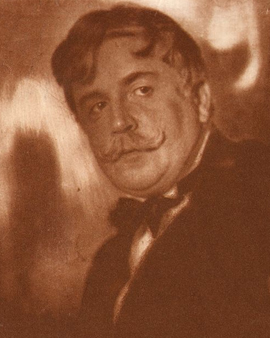


The Russian artist Aleksandr Yakovlevich Golovin was the creative mind behind many theatre, ballet and opera productions in his home country and was also known as a talented painter. Born in 1863, Golovin worked as a painter, draughtsman and illustrator and collaborated with top-class Russian directors and dramaturges. He not only developed impressive stage sets for their plays, but was also gladly hired as a costume designer. Among others, Golovin developed his innovative ideas and concepts for productions by Sergei Diaghilev, Constantin Stanislavski and Vsevolod Meyerhold. He also provided the set design for the original production of Stravinsky's ballet "The Firebird" from 1910. Golovin also worked as a set and costume designer for Pierre Beaumarchais' production of the famous play "The Marriage of Figaro" at the Moscow Art Theatre.
Golovin was born in the metropolis of Moscow. As a young man he first studied architecture. After mature consideration he later changed to the freer study of painting. He received lessons both in his home town and in Paris. After graduating, the young artist had to earn his living as a craftsman and decorator. Inspired by this, the creative Golovin tried out new artistic fields, for example designing furniture. At the Paris World Exhibition in 1900, he was largely responsible for designing the Russian pavilion. He was showered with praise and received excellent reviews. A year later Golovin moved from Moscow to the St. Petersburg region. Here he started his career as a set designer for theatre and opera plays. He was able to respond to the hip Symbolist movement in a highly modern way and combine both in his work. His costume sketches sparkle with fantasy. After the Russian Revolution of 1917, the star of the theatre scene got into financial difficulties, as there were fewer and fewer performances in the theatre and nobody was able to engage him. Therefore the now 53-year-old decided to take a closer look at painting, which he had given up for working in the theatre. With graphic illustrations he was able to secure a new foothold, which was of economic benefit to him.
Golovin is still considered one of the most important and influential stage designs of the former Russian Federation. The diverse artist influenced generations of international creative and cultural workers. He died on 17 April 1930 at the age of 67 in the city of Detskoye Selo.

The Russian artist Aleksandr Yakovlevich Golovin was the creative mind behind many theatre, ballet and opera productions in his home country and was also known as a talented painter. Born in 1863, Golovin worked as a painter, draughtsman and illustrator and collaborated with top-class Russian directors and dramaturges. He not only developed impressive stage sets for their plays, but was also gladly hired as a costume designer. Among others, Golovin developed his innovative ideas and concepts for productions by Sergei Diaghilev, Constantin Stanislavski and Vsevolod Meyerhold. He also provided the set design for the original production of Stravinsky's ballet "The Firebird" from 1910. Golovin also worked as a set and costume designer for Pierre Beaumarchais' production of the famous play "The Marriage of Figaro" at the Moscow Art Theatre.
Golovin was born in the metropolis of Moscow. As a young man he first studied architecture. After mature consideration he later changed to the freer study of painting. He received lessons both in his home town and in Paris. After graduating, the young artist had to earn his living as a craftsman and decorator. Inspired by this, the creative Golovin tried out new artistic fields, for example designing furniture. At the Paris World Exhibition in 1900, he was largely responsible for designing the Russian pavilion. He was showered with praise and received excellent reviews. A year later Golovin moved from Moscow to the St. Petersburg region. Here he started his career as a set designer for theatre and opera plays. He was able to respond to the hip Symbolist movement in a highly modern way and combine both in his work. His costume sketches sparkle with fantasy. After the Russian Revolution of 1917, the star of the theatre scene got into financial difficulties, as there were fewer and fewer performances in the theatre and nobody was able to engage him. Therefore the now 53-year-old decided to take a closer look at painting, which he had given up for working in the theatre. With graphic illustrations he was able to secure a new foothold, which was of economic benefit to him.
Golovin is still considered one of the most important and influential stage designs of the former Russian Federation. The diverse artist influenced generations of international creative and cultural workers. He died on 17 April 1930 at the age of 67 in the city of Detskoye Selo.
Page 1 / 2






